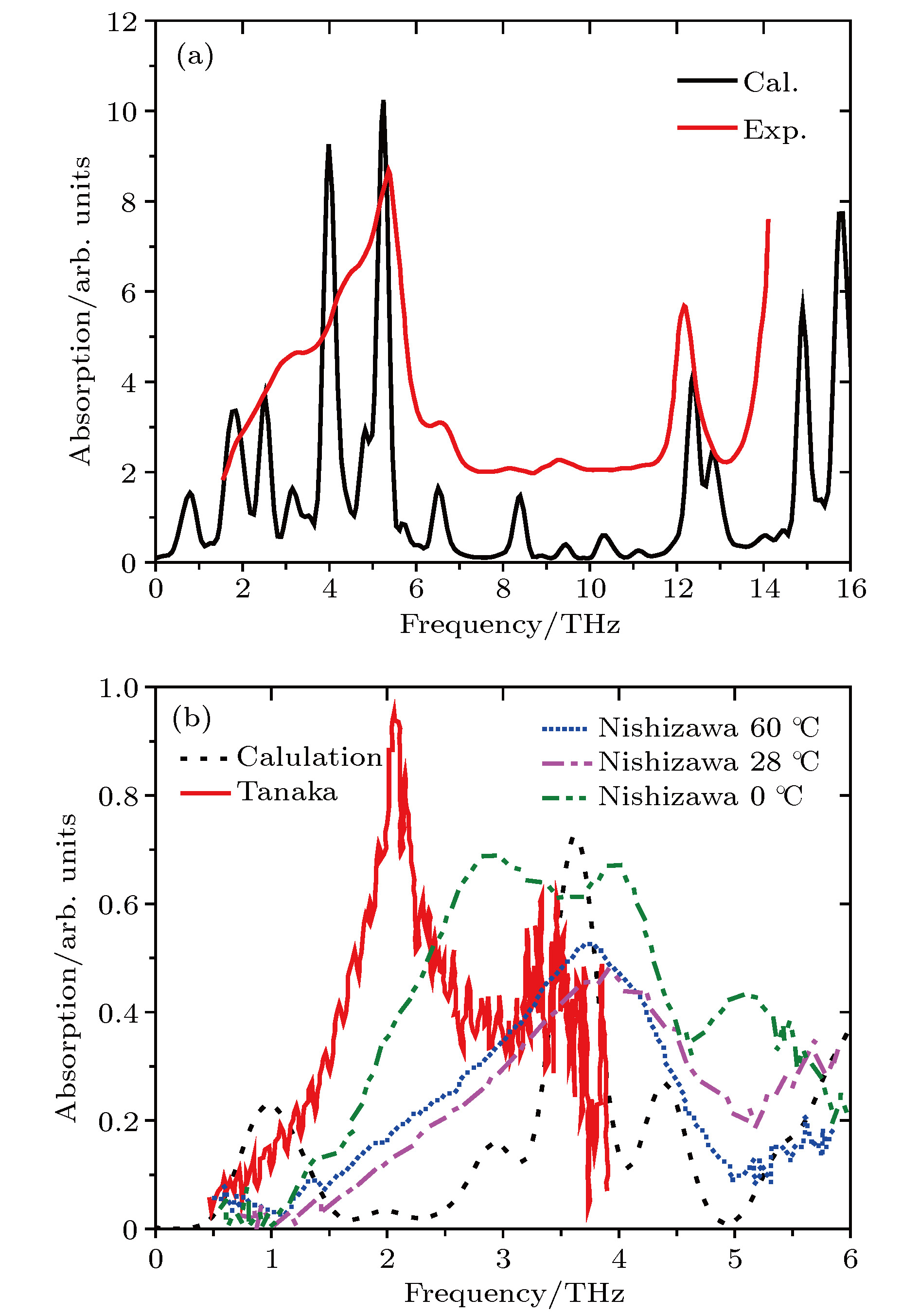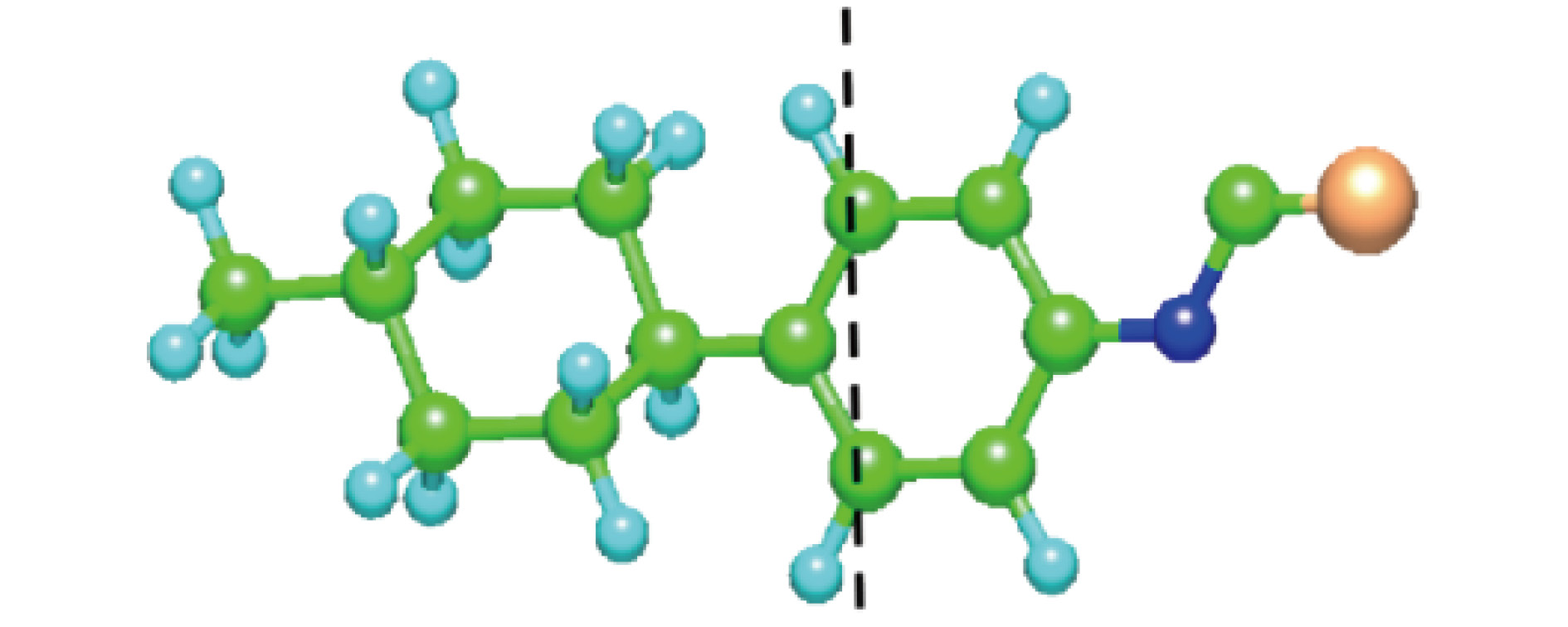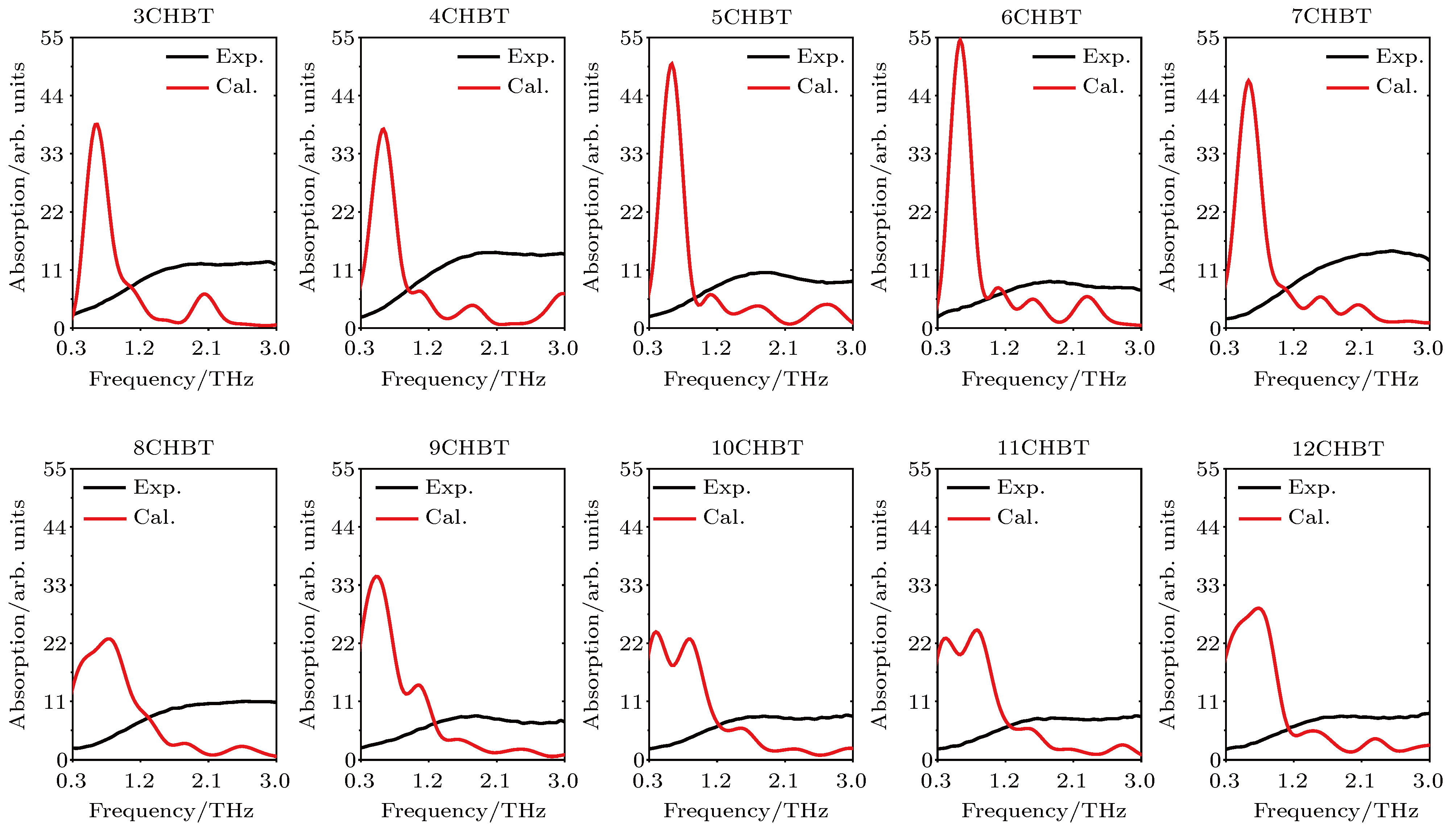-
基于密度泛函理论, 利用Gaussian09程序包, 通过Opt + Freq优化结构, 以B3LYP/6-311g基组对4-(trans-4-n-alkylcyclohexyl) isothiocyanatobenzenes (CHBT) 16种液晶分子在0.1—5.0 THz波段的吸收进行研究, 提出了通过考察分子转动惯量和质量重心偏移对太赫兹吸收的影响方法. 计算结果表明, 随着分子烷基链上碳原子数目增加, 分子的转动惯量和重心的偏移将对太赫兹波的吸收产生影响. 在0.1—5.0 THz波段, 3—7个碳原子的分子吸收相对较强. 以此为参照, 减少和增加烷基链上的碳原子数目都会降低分子对太赫兹波的吸收. 在0.3—3.0 THz范围内, 将计算结果与10种有实验数据的分子进行了对比. 结果发现, 低频波段计算结果与实验测量相比存在差异, 其中吸收峰位置的差异可能来源于氢键. 比较吸收强度的相对大小值, 发现实验测量与计算结果较为一致, 表明吸收强度来源于偶极子振动、转动吸收, 展现了计算模拟的积极意义. 研究结果可对相关分子的设计与合成提供有用的建议.According to density functional theory, in this paper we report a simulation result obtained by using the Gaussian09 package. Adopted in the calculation are an optimized Opt Freq and a base group of B3LYP/6-311g to simulate the absorption of 16 kinds of liquid crystal (LC) molecules of 4-(trans-4-n-alkylcyclohexyl) isothiocyanatobenzenes (CHBT) in a 0.1−5.0 terahertz band (THz). The results show that in the low terahertz band, the absorption is caused mainly by the vibration and rotation of the molecules. So for convenience, we present an novel analytical method of studying the influence of molecular moment of inertia and mass center of gravity shift on absorption. An important result is found that the length of the molecular alkyl chain can lead to different molecular mass, mass center of gravity and moment of inertia, which causes the rotation and vibration of the molecule to be different. These factors lead to the difference in terahertz wave absorption. In the 0.1−5.0 terahertz band, the molecules with 3−7 alkyl chain carbon atoms show a strong absorption. As a reference, reducing and increasing the carbon atoms in the alkyl chain will cause the molecules to reduce the absorption of terahertz waves . In the end, the calculated results are compared with the experimental results obtained from 10 molecules according to the reference data in a frequency range of 0.3−3.0 terahertz. It is found that in the low frequency band there exist some differences between the calculation results and the experimental measurements, in which the difference in the position of the absorption peak may originate from a hydrogen bond. Comparing the relative magnitudes of the absorption intensities, it is found that the experimental measurements are consistent with the calculated results, indicating that the absorption intensity comes from the absorption of dipole vibration and rotation, which demonstrates the positive significance of computational simulation. We look forward to the experimental measurements in the future, and correct the calculation methods and keywords as well as the parameters such as temperature calculation that is to be done in future work. As a theoretical basis, the calculation results can better reflect the absorption of molecular materials, and it is expected to provide useful suggestions for designing and synthesizing the liquid crystal molecules.
-
Keywords:
- liquid crystal /
- terahertz /
- alkyl chains /
- Gaussian
[1] Lagerwall J P F, Scalla G 2012 Curr. Appl. Phys. 12 1387
 Google Scholar
Google Scholar
[2] Ghasemi M, Choudhury P K, Pankaj K 2014 J. Nanophoton. 8 083997
 Google Scholar
Google Scholar
[3] Kumar R, Aain K K 2014 Liq. Cryst. 41 228
 Google Scholar
Google Scholar
[4] Bisoy H K, Li Q 2014 Acc Chem. Res. 47 3184
 Google Scholar
Google Scholar
[5] Hartmann R R, Kono J, Portnoi M E 2014 Nanotechnology 25 1
[6] 李弦 2016 博士学位论文 (杭州: 浙江大学)
Li X 2016 Ph. D. Dissertation (Hangzhou: Zhejiang University) (in Chinese)
[7] Dhillon S S, Vitiello M S, Linfield E H 2017 J. Phys. D: Appl. Phys. 50 043001
 Google Scholar
Google Scholar
[8] Zhao L, Hao Y H, Peng R Y 2014 Mil. Med. Res. 27 p1
[9] Mittleman D M 2017 J. Appl. Phys. 122 p1
[10] 陈泽章 2016 博士学位论文(新乡: 河南师范大学)
Chen Z Z 2016 Ph. D. Dissertation (Xinxiang: Henan Normal University) (in Chinese)
[11] Mueller E R 2006 Photon. Spectra 40 p60
[12] Park H, Fan F, Li M M, Han H, Chigrinov V G, Macpherson E 2011 36th International Conference on Infrared, Millimeter, and Terahertz Waves Houston, USA, 2011 p6104918
[13] Ma H 2004 Ph. D. Dissertation (Toyama: Toyama University)
[14] Vieweg N, Shakfa M K, Scherger B, Mikulics M, Koch M 2010 J. Infrared Millim. Terahertz Waves 31 1312
 Google Scholar
Google Scholar
[15] Wang L, Ge S J, Hu W, Nakajima M, Lu Y Q 2017 Opt. Mater. Express 7 2023
 Google Scholar
Google Scholar
[16] Silverstein R M, Webster F X, Kiemle D J 2005 Spectrometric Identification of Organic Compounds (7th Ed.) (New york: John Wiley & Sons) p512
[17] Ma H, Shi D H, He J, Peng Y F 2009 Chin. Phys. B 18 1085
 Google Scholar
Google Scholar
[18] Dong J Q, Cheng W Q, Li M G, Wang K L, Ma H 2017 J. Phys. D: Appl. Phys. 50 1
[19] Chodorow U, Parka J, Garbat K, Robb M A 2015 Liq. Cryst. 40 1089
[20] Frisch M J, Trucks G W, Cheeseman J R, et al. 2013 Gaussian, Inc, Wallingford 1 09
[21] Peng F L, Chen Y, Wu S T, Tripathi S, Twieg R G 2014 Liquid Crystals 41 1545
 Google Scholar
Google Scholar
[22] Depalma J W, Bzdek B R, Ridge D P, Johnston M V 2014 J. Phys. Chem. A 118 11547
 Google Scholar
Google Scholar
[23] Kreutzer J, Blahal P, Schubert U 2016 Comput. Theor. Chem 1084 162
 Google Scholar
Google Scholar
[24] Priest C, Zhou J W, Jiang D E 2017 Inor. Chim. Acta 458 39
 Google Scholar
Google Scholar
[25] 王雅昕, 程雅青, 王凯礼, 陈洋玮, 阎昊岚, 袁秋林, 马恒 2018 液晶与显示 33 645
Wang Y X, Cheng Y Q, Wang K L, Chen Y W, Yan H L, Yuan Q L, Ma H 2018 Chin. J. Liquid Crystals and Displays 33 645
[26] 董建奇, 程文其, 李梦阁, 王凯礼, 马恒 2017 液晶与显示 32 590
Dong J Q, Cheng W Q, Li M G, Wang K L, Ma H 2017 Chin. J. Liquid Crystals and Displays 32 590
[27] Vieweg N, Fischer B M, Reuter M, Kula P, Dabrowski R, Celik M A, Frenking G, Koch M, Jepsen P U 2012 Opt. Express 20 28249
 Google Scholar
Google Scholar
[28] Parka J, Sielezin K 2017 Molecular Crystals and Liquid Crystals 657 66
 Google Scholar
Google Scholar
[29] Vieweg N, Celik M A, Zakel S, Gupta V, Frenking G, Koch M 2014 J. Infrared, Millimeter and Terahertz Waves 35 478
 Google Scholar
Google Scholar
-
表 1 16个分子各个组成部分的原子质量
Table 1. Atom mass of each component of 16 molecules.
nCHBT NCS/
g·mol–1Benzene/
g·mol–1NCS+ Benzene/
g·mol–1Cyclohexane/
g·mol–1NCS+ Benzene +
Cyclohexane/g· mol–1CnH2n+1/
g·mol–1Cyclohexane + CnH2n+1/
g·mol–10CHBT 58 76 134 82 216 1 83 1CHBT 58 76 134 82 216 15 97 2CHBT 58 76 134 82 216 29 111 3CHBT 58 76 134 82 216 43 125 4CHBT 58 76 134 82 216 57 139 5CHBT 58 76 134 82 216 71 153 6CHBT 58 76 134 82 216 85 167 7CHBT 58 76 134 82 216 99 181 8CHBT 58 76 134 82 216 113 195 9CHBT 58 76 134 82 216 127 209 10CHBT 58 76 134 82 216 141 223 11CHBT 58 76 134 82 216 155 237 12CHBT 58 76 134 82 216 169 251 13CHBT 58 76 134 82 216 183 265 14CHBT 58 76 134 82 216 197 279 15CHBT 58 76 134 82 216 211 293 -
[1] Lagerwall J P F, Scalla G 2012 Curr. Appl. Phys. 12 1387
 Google Scholar
Google Scholar
[2] Ghasemi M, Choudhury P K, Pankaj K 2014 J. Nanophoton. 8 083997
 Google Scholar
Google Scholar
[3] Kumar R, Aain K K 2014 Liq. Cryst. 41 228
 Google Scholar
Google Scholar
[4] Bisoy H K, Li Q 2014 Acc Chem. Res. 47 3184
 Google Scholar
Google Scholar
[5] Hartmann R R, Kono J, Portnoi M E 2014 Nanotechnology 25 1
[6] 李弦 2016 博士学位论文 (杭州: 浙江大学)
Li X 2016 Ph. D. Dissertation (Hangzhou: Zhejiang University) (in Chinese)
[7] Dhillon S S, Vitiello M S, Linfield E H 2017 J. Phys. D: Appl. Phys. 50 043001
 Google Scholar
Google Scholar
[8] Zhao L, Hao Y H, Peng R Y 2014 Mil. Med. Res. 27 p1
[9] Mittleman D M 2017 J. Appl. Phys. 122 p1
[10] 陈泽章 2016 博士学位论文(新乡: 河南师范大学)
Chen Z Z 2016 Ph. D. Dissertation (Xinxiang: Henan Normal University) (in Chinese)
[11] Mueller E R 2006 Photon. Spectra 40 p60
[12] Park H, Fan F, Li M M, Han H, Chigrinov V G, Macpherson E 2011 36th International Conference on Infrared, Millimeter, and Terahertz Waves Houston, USA, 2011 p6104918
[13] Ma H 2004 Ph. D. Dissertation (Toyama: Toyama University)
[14] Vieweg N, Shakfa M K, Scherger B, Mikulics M, Koch M 2010 J. Infrared Millim. Terahertz Waves 31 1312
 Google Scholar
Google Scholar
[15] Wang L, Ge S J, Hu W, Nakajima M, Lu Y Q 2017 Opt. Mater. Express 7 2023
 Google Scholar
Google Scholar
[16] Silverstein R M, Webster F X, Kiemle D J 2005 Spectrometric Identification of Organic Compounds (7th Ed.) (New york: John Wiley & Sons) p512
[17] Ma H, Shi D H, He J, Peng Y F 2009 Chin. Phys. B 18 1085
 Google Scholar
Google Scholar
[18] Dong J Q, Cheng W Q, Li M G, Wang K L, Ma H 2017 J. Phys. D: Appl. Phys. 50 1
[19] Chodorow U, Parka J, Garbat K, Robb M A 2015 Liq. Cryst. 40 1089
[20] Frisch M J, Trucks G W, Cheeseman J R, et al. 2013 Gaussian, Inc, Wallingford 1 09
[21] Peng F L, Chen Y, Wu S T, Tripathi S, Twieg R G 2014 Liquid Crystals 41 1545
 Google Scholar
Google Scholar
[22] Depalma J W, Bzdek B R, Ridge D P, Johnston M V 2014 J. Phys. Chem. A 118 11547
 Google Scholar
Google Scholar
[23] Kreutzer J, Blahal P, Schubert U 2016 Comput. Theor. Chem 1084 162
 Google Scholar
Google Scholar
[24] Priest C, Zhou J W, Jiang D E 2017 Inor. Chim. Acta 458 39
 Google Scholar
Google Scholar
[25] 王雅昕, 程雅青, 王凯礼, 陈洋玮, 阎昊岚, 袁秋林, 马恒 2018 液晶与显示 33 645
Wang Y X, Cheng Y Q, Wang K L, Chen Y W, Yan H L, Yuan Q L, Ma H 2018 Chin. J. Liquid Crystals and Displays 33 645
[26] 董建奇, 程文其, 李梦阁, 王凯礼, 马恒 2017 液晶与显示 32 590
Dong J Q, Cheng W Q, Li M G, Wang K L, Ma H 2017 Chin. J. Liquid Crystals and Displays 32 590
[27] Vieweg N, Fischer B M, Reuter M, Kula P, Dabrowski R, Celik M A, Frenking G, Koch M, Jepsen P U 2012 Opt. Express 20 28249
 Google Scholar
Google Scholar
[28] Parka J, Sielezin K 2017 Molecular Crystals and Liquid Crystals 657 66
 Google Scholar
Google Scholar
[29] Vieweg N, Celik M A, Zakel S, Gupta V, Frenking G, Koch M 2014 J. Infrared, Millimeter and Terahertz Waves 35 478
 Google Scholar
Google Scholar
计量
- 文章访问数: 11312
- PDF下载量: 59
- 被引次数: 0














 下载:
下载:







